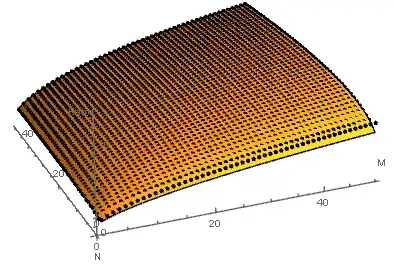Following Anton Malyshev's idea, $a_k$ can be regarded as the probability function of the random variable $Y=\sum_{i=1}^n X_i$, where $X_i$ are iid uniform discrete variables - (except for a normalization factor which will be cancelled in the division, hence we'll ignore it).
For simplicity, let's assume $m$ is odd, so that $X_i$ takes values over $\{ \frac{-m+1}{2}, \cdots -1, 0, 1 \cdots \frac{m-1}{2} \}$.
Notice also that $\sum a_k^2 = P(Y_1=Y_2) = P(Y_1 - Y_2 = 0)$ where $Y_1$,$Y_2$ are two iid random variables following the pmf $a_k$.
Let's then define $W_i = X_{i,1} - X_{i,2}$, so that $Z = \sum W_i = Y_1 - Y_2$.
Then, we want to evaluate the ratio
$$ A(m,n)= \frac{\sqrt{P(Z=0)}}{P(Y=0)}=\frac{\sqrt{P(\sum W_i=0)}}{P(\sum X_i=0)} \tag 1$$
where both $Z$ and $Y$ are integer valued with zero mean.
For that we use the CLT and, for refinement, this Edgeworth expansion.
We have the following first moments (odd moments are zero), and fourth cumulant:
$$\begin{array}{c|c|c|}
& X_i & W_i \\ \hline
m_2=\sigma^2& \displaystyle{\frac{m^2-1}{12}} & \displaystyle{\frac{m^2-1}{6}} \\
m_4 & \displaystyle{\frac{3 m^4-10m^2+7}{240} }&
\displaystyle{\frac{2 {{m}^{4}}-5 {{m}^{2}}+3}{30}} \\
\kappa_4 & \displaystyle{-\frac{{{m}^{4}}-1}{120} }&
\displaystyle{-\frac{{{m}^{4}}-1}{60}} \\
\end{array} \tag 2$$
Then the zero order approximation gives
$$ A(m.n) \approx \frac{(2 \pi n \,\sigma_X^2)^{1/2}}{(2 \pi n \, \sigma_W^2)^{1/4}} = \left( \pi \,n \, \frac{m^2-1}{12}\right)^{1/4} \triangleq A_0(m.n) \tag 3$$
And the first order correction is
$$ \begin{align} A(m,n) &\approx
A_0(m,n)\frac{\sqrt{ 1+ \displaystyle{\frac{\kappa_{4,W}}{8 n \sigma_W^4}}}}{1+\displaystyle{\frac{\kappa_{4,X}}{8 n \sigma_X^4}}} \\ &= \left( \pi \,n \, \frac{m^2-1}{12}\right)^{1/4} \frac{\sqrt{1-\displaystyle{\frac{3 \left( {{m}^{2}}+1\right) }{40 n\, \left( {{m}^{2}}-1\right) }}}}{1-\displaystyle{\frac{3 \left( {{m}^{2}}+1\right) }{20 n\, \left( {{m}^{2}}-1\right) }}} \triangleq A_1(m.n) \tag 4
\end{align}$$
The approximations are quite good, even for small values of $n$:
$$
\begin{array}{c|c|c|c|c}
n & m & {A(m,n) \text{ (exact)}} & A_0(m,n) & A_1(m,n)\\ \hline
3 & 3 & 1.6963 & 1.5832 & 1.6622 \\
5 & 3 & 1.8535 & 1.7989 & 1.8514 \\
10 & 3 & 2.1698 & 2.1393 & 2.1699 \\
20 & 3 & 2.5621 & 2.5440 & 2.5621 \\ \hline
3 & 9 & 2.9627 & 2.8154 & 2.9292 \\
5 & 9 & 3.2779 & 3.1989 & 3.2750 \\
10 & 9 & 3.8491 & 3.8042 & 3.8487 \\
20 & 9 & 4.5504 & 4.5240 & 4.5503 \\
30 & 9 & 5.0260 & 5.0066 & 5.0260 \\
\end{array}
$$
Both are expected to be asympotically exact (vanishing relative error) for $n \to \infty$. From $(4)$ one can conjecture:
$$ A(m,n) = \left( \pi \,n \, \frac{m^2-1}{12}\right)^{1/4}
\left( 1 + \frac{1}{n}\frac{9}{ 80} \frac{m^2+1}{m^2-1} + O( n^{-2}) \right) \tag 5
$$
